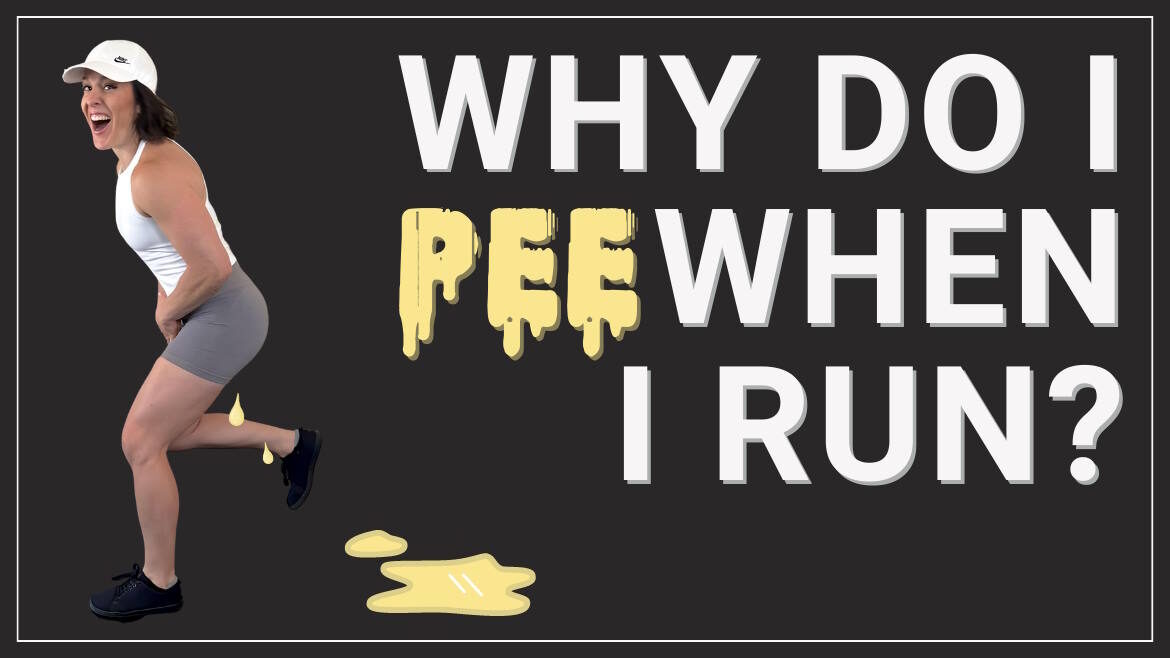It’s a beautiful day, so you head out for a post-baby jog, and it happens. You pee your pants! What’s causing incontinence when you run, and how can you fix it?
Loss of bladder control, or stress urinary incontinence, is prevalent among postnatal runners. In fact, about one in three women experience varying degrees of urinary incontinence after birth. Just because these symptoms are common, doesn’t mean it’s normal, or that you need to live with it.
Before we get into it, please remember running is NOT recommended until you’re at least 12 weeks postpartum. Your body – pelvic floor and core in particular – just experienced major trauma. Running is high impact! Take time to allow your body to heal, and work on rebuilding strength postpartum prior to running.
Your Pelvic Floor and Running
So, it may seem logical that if you pee when you run it’s because your pelvic floor is weak. This is sometimes the case, but often, stress incontinence is a result of an overly tight pelvic floor.
Female athletes often return to running postpartum with a weak pelvic floor, core, and glutes. This causes your quads to overcompensate. It can lead to low back pain, tight hamstrings, and a lot of extra pressure on your pelvic floor.
Your pelvic floor, abdominals, and glutes work in tandem. So if your core is weak postpartum, your pelvic floor muscles are going to try to make up for it.
Why a Tight Pelvic Floor Can Contribute to Leaking
Your pelvic floor is a bowl of muscles. And if they are constantly tight, they can’t handle added pressure.
Here’s a good analogy. If you walked around flexing your bicep nonstop, your bicep muscles would get really fatigued. Then if you were asked to hold a weight with your tired arm, that muscle would give out.
Similarly, if your pelvic floor is working overtime to create stability, it is likely tight and overworked. Add in the impact of running, and your pelvic floor simply can’t hold it together.
Are Your Leaks From a Tight or Weak Pelvic Floor?
The only way to know for sure if your pelvic floor is tight is by seeing a pelvic floor therapist. However, there are a few telltale signs that point to a hypertonic, or overly tight, pelvic floor. These symptoms can also impact bladder control:
- Glute or jaw clenching
- Constipation issues
- Feeling pain in your tailbone, hips, or lower back
- You find it hard to keep a tampon in
To further complicate things, it’s totally possible for your pelvic floor to be tight AND weak at the same time. This is why it is always recommend to see a physical therapist if you suspect pelvic floor issues.
How Do I Stop Incontinence While Running?
The pelvic floor is a bowl of muscles that hold and support your pelvic organs. Glute and core strength is critical for a strong and supported pelvic floor, and ultimately less bladder leakage.
Pelvic Floor Exercises
I rarely recommend Kegel exercises for strengthening your pelvic floor. Many female athletes have an already tight pelvic floor, and Kegels can make the problem worse. Instead, learn to relax your pelvic floor and take it through its full range of motion.
Strengthen Your Core and Glutes
Strengthening often-ignored muscle groups helps improve incontinence. Running is mostly completed in the sagittal, or forward/backward, plane of motion. Runners – especially postpartum moms – tend to have a lot of quad dominance and weaker glutes.
Our glutes “turn off” in pregnancy. If we don’t take time focus on glute-specific training postpartum, they often don’t return to full strength. It is important to incorporate side, or lateral, movements into workouts. These exercises build up the glute muscles, abductors, adductors, and hips.
Grab some bands and these exercises a few times a week:
Exercises To Reduce Incontinence When Running
Banded Ski Jump Squat
- Place a long resistance band around your hips (anchored at about hip height). Take a few steps out to make the band nice and taut. Think “ski jump” position.
- Inhale through your nose and squat down. Exhale audibly through your mouth as you rise. Squeeze glutes at the top.
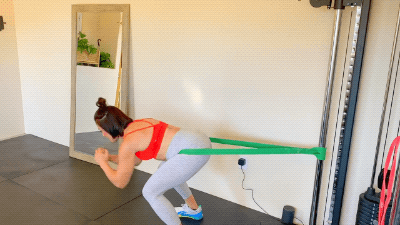
Ball Push Hip Hinge
- Place a small Pilates ball on the wall, next to your knee. Your back foot (the one pressing into the ball) is either down, acting like a kickstand or completely off the ground.
- Inhale as you lean forward to hinge at the hips and stretch the glutes.
- Exhale as you rise back up and press into the ball. This is key to this exercise since it activates the glute muscles on both sides.
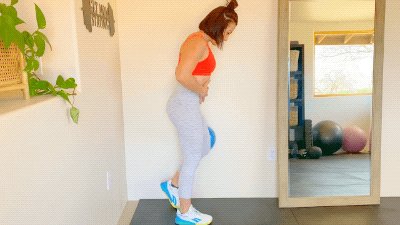
Banded Lateral Walk
- Place a band around your ankles. Breathe in through your nose, and as you exhale scoop your tummy up and in.
- Take a step out to the side. The key to this exercise is not to let your knees cave in!
- Repeat a few steps in one direction then step to the other side. Repeat.
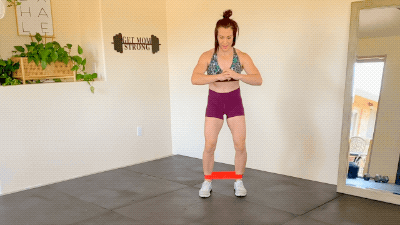
Monster Walk
- Place a band around your ankles with a slight bend in the knees.
- Set your core with a big inhale through the nose, then exhale through the mouth.
- Scoop your tummy in and up as you take a step out/forward.
- Alternate your feet, keeping tension on the band. (Think “out – together – out – together.”)

Elevated Bridge with Band Abduction
- Lay on your back, feet up on an elevated surface.
- Band is around your knees, inhale while your back is on the ground.
- Exhale, lift your pelvic floor as you lift your hips, and gently press knees out against the band.
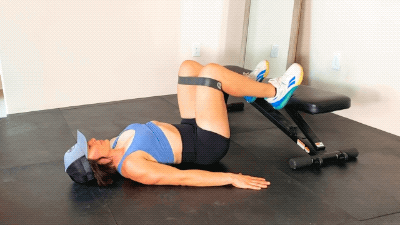
Bridge with Ball Squeeze
- Lay on your back, knees bent and feet on the floor, with a small Pilates ball between your knees. Make sure your heels are in close to your butt so you can feel this in your glutes.
- Inhale through your nose and release any tension on the ball, keeping your back is on the ground.
- Exhale through your mouth as you squeeze the ball and lift your butt and lower back off the floor. Release down and repeat.
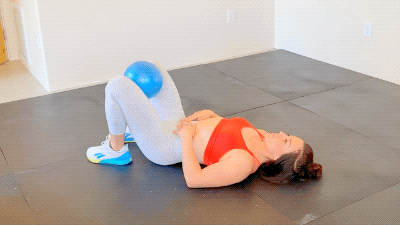
Check Your Posture
Lastly, check your running posture. Do you run with your body straight up and down? If so, this creates a lot of unnecessary impact on your pelvic floor, worsening incontinence symptoms.
The key is to lean forward slightly as you run, which will better activate your glutes and pelvic floor.
Hill Walks to Help with Running Posture
Start by walking on an incline. This will help get your glutes stronger and cue better posture for running.
Next, try running up a hill and walking back down it. Hill repeats are a great way to keep running lower impact, while also building better strength and mechanics.
You Don’t Have To Live with Bladder Leaks
You don’t have to have to leak urine while running, jumping, coughing, or laughing. There are non-surgical treatment options. Exercises that teach your pelvic floor to lengthen and relax, as well as contract, can help you regain function in all physical activities.
Take the time to rebuild your core and glute strength. It will have a long-term impact on bladder and urine leakage issues. Your strong mom body will thank you!
Need Help Getting Back to Running Leak-Free?
Check out the Strong Like A Mother (SLAM) program by Get Mom Strong. This comprehensive strength-building program helps teach you to take your pelvic floor through its full range of motion. The program also focuses on building functional strength with special attention to the glutes, core and pelvic floor.
